Tummy Tuck > Procedures
Also known as abdominoplasty, a tummy tuck
removes excess fat and skin, and in most cases restores weakened or
separated muscles creating an abdominal profile that is smoother and
firmer.
Beauty for life:
 Enhancing
your appearance with a tummy tuck Enhancing
your appearance with a tummy tuck
A
flat and well-toned abdomen is something many of us strive for through
exercise and weight control. Sometimes these methods cannot achieve our
goals. Even
individuals of otherwise normal body weight and proportion can develop
an abdomen that protrudes or is loose and sagging. The most common
causes of this include:
 Pregnancy Pregnancy
 Aging Aging
 Significant fluctuations in weight Significant fluctuations in weight
 Heredity Heredity
 Prior surgery Prior surgery
Also
known as abdominoplasty, a tummy tuck removes excess fat and skin, and
in most cases restores weakened or separated muscles creating an
abdominal profile that is smoother and firmer. What it won’t do:A tummy tuck is not a substitute for weight loss or an appropriate exercise program. Although
the results of a tummy tuck are technically permanent, the positive
outcome can be greatly diminished by significant fluctuations in your
weight. For this reason, individuals who are planning substantial
weight loss or women who may be considering future pregnancies may be
advised to postpone a tummy tuck. Also,
a tummy tuck cannot correct stretch marks, although these may be
removed or somewhat improved if they are located on the areas of excess
skin that will be excised, generally those treated areas below the
belly button. Is it right for me?Tummy
tuck surgery is a highly individualized procedure and you should do it
for yourself, not to fulfill someone else’s desires or to try to fit
any sort of ideal image. Abdominoplasty is a good option for you if:
 You are physically healthy and at a stable weight You are physically healthy and at a stable weight
 You have realistic expectations You have realistic expectations
 You are a non-smoker You are a non-smoker
 You are bothered by the feeling that your tummy is too large You are bothered by the feeling that your tummy is too large
Back to Top What to expect during your consultationThe
success and safety of your tummy tuck procedure depends very much on
your complete candidness during your consultation. You’ll be asked a
number of questions about your health, desires and lifestyle. Be prepared to discuss:
 Why you want the surgery, your expectations and desired outcome Why you want the surgery, your expectations and desired outcome
 Medical conditions, drug allergies and medical treatments Medical conditions, drug allergies and medical treatments
 Use of current medications, vitamins, herbal supplements, alcohol, tobacco and drugs Use of current medications, vitamins, herbal supplements, alcohol, tobacco and drugs
 Previous surgeries Previous surgeries
Your surgeon may also:
 Evaluate your general health status and any pre-existing health conditions or risk factors Evaluate your general health status and any pre-existing health conditions or risk factors
 Take photographs for your medical record Take photographs for your medical record
 Discuss your options and recommend a course of treatment Discuss your options and recommend a course of treatment
 Discuss likely outcomes of the tummy tuck and any risks or potential complications Discuss likely outcomes of the tummy tuck and any risks or potential complications
Back to Top Preparing for surgeryPrior to surgery, you may be asked to:
 Get lab testing or a medical evaluation Get lab testing or a medical evaluation
 Take certain medications or adjust your current medications Take certain medications or adjust your current medications
 Stop smoking well in advance of surgery Stop smoking well in advance of surgery
 Avoid taking aspirin, anti-inflammatory drugs and herbal supplements as they can increase bleeding Avoid taking aspirin, anti-inflammatory drugs and herbal supplements as they can increase bleeding
Special instructions you receive will cover:
 What to do on the day of surgery What to do on the day of surgery
 The use of anesthesia during your tummy tuck The use of anesthesia during your tummy tuck
 Post-operative care and follow-up Post-operative care and follow-up
Back to Top Important facts about the safety and risks of abdominoplastyThe
decision to have tummy tuck surgery is extremely personal and you’ll
have to decide if the benefits will achieve your goals and if the risks
and potential complications are acceptable. Your
plastic surgeon and/or staff will explain in detail the risks
associated with surgery. You will be asked to sign consent forms to
ensure that you fully understand the procedure you will undergo and any
risks or potential complications. Possible risks of abdominoplasty include:
 Unfavorable scarring Unfavorable scarring
 Bleeding (hematoma) Bleeding (hematoma)
 Infection Infection
 Fluid accumulation Fluid accumulation
 Poor wound healing Poor wound healing
 Skin loss Skin loss
 Blood clots Blood clots
 Numbness or other changes in skin sensation Numbness or other changes in skin sensation
 Anesthesia risks Anesthesia risks
 Skin discoloration and/or prolonged swelling Skin discoloration and/or prolonged swelling
 Fatty tissue found deep in the skin might die (fat necrosis) Fatty tissue found deep in the skin might die (fat necrosis)
 Major wound separation Major wound separation
 Asymmetry Asymmetry
 Recurrent looseness of skin Recurrent looseness of skin
 Pain, which may persist Pain, which may persist
 Deep vein thrombosis, cardiac and pulmonary complications Deep vein thrombosis, cardiac and pulmonary complications
 Persistent swelling in the legs Persistent swelling in the legs
 Nerve damage Nerve damage
 Possibility of revisional surgery Possibility of revisional surgery
 Suboptimal aesthetic result Suboptimal aesthetic result
You’ll need helpIf
your abdominoplasty is performed on an outpatient basis, be sure to
arrange for someone to drive you to and from surgery and to stay with
you for at least the first night following surgery. Back to Top Procedural Steps:What happens during tummy tuck surgery?Step 1 – AnesthesiaMedications
are administered for your comfort during the surgical procedures. The
choices include intravenous sedation and general anesthesia. Your
doctor will recommend the best choice for you. Step 2 – The incisionA
full tummy tuck requires a horizontally-oriented incision in the area
between the pubic hairline and navel. The shape and length of the
incision will be determined by the degree of correction necessary. Through this incision, weakened abdominal muscles are repaired and sutured and excess fat, tissue and skin is removed. A second incision around the navel may be necessary to remove excess skin in the upper abdomen. 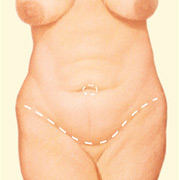 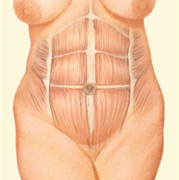
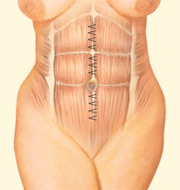 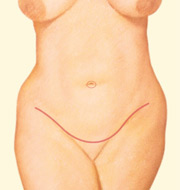
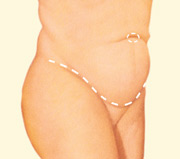 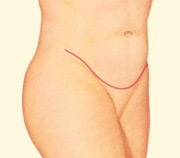
Step 3 – Closing the incisionsSutures, skin adhesives, tapes or clips close the skin incisions. Step 4 – See the resultsYour tummy tuck will result in a flatter, firmer abdominal contour that is more proportionate with your body type and weight. The
final results may be initially obscured by swelling and your inability
to stand fully upright until internal healing is complete. Within a week or two, you should be standing tall and confident about your new slimmer profile. Back to Top My recovery Following
your surgery, dressings or bandages may be applied to your incisions,
and you may be wrapped in an elastic bandage or a compression garment
to minimize swelling and to support your abdomen as it heals. Following
your surgery, dressings or bandages may be applied to your incisions,
and you may be wrapped in an elastic bandage or a compression garment
to minimize swelling and to support your abdomen as it heals.
A small, thin tube may be temporarily placed under the skin to drain any excess blood or fluid that may collect. You will be given specific instructions that may include:
How to care for the surgical site and drains, medications to apply or
take orally to aid healing and reduce the potential for infection,
specific concerns to look for at the surgical site or in your general
health, and when to follow-up with your plastic surgeon. Be sure to ask your plastic surgeon specific questions about what you can expect during your individual recovery period.
 Where will I be taken after my surgery is complete? Where will I be taken after my surgery is complete?
 What medication will I be given or prescribed after surgery? What medication will I be given or prescribed after surgery?
 Will I have dressings/bandages after surgery? Will I have dressings/bandages after surgery?
 When will they be removed? When will they be removed?
 Are stitches removed? When? Are stitches removed? When?
 When can I resume normal activity and exercise? When can I resume normal activity and exercise?
 When do I return for follow-up care? When do I return for follow-up care?
Previous
abdominal surgery may limit the potential results of a tummy tuck. In
women who have undergone cesarean section, the existing scars may often
be incorporated into the new scar. Back to Top How much will tummy tuck surgery cost?Cost
is always a consideration in elective surgery. Prices for tummy tucks
can vary widely. A surgeon’s cost for a tummy tuck may vary based on
his or her experience, the type of procedure used, as well as
geographic office location. Many plastic surgeons offer patient financing plans, so be sure to ask. Cost may include:
 Surgeon’s fee Surgeon’s fee
 Hospital or surgical facility costs Hospital or surgical facility costs
 Anesthesia fees Anesthesia fees
 Prescriptions for medication Prescriptions for medication
 Post-surgery garments, and Post-surgery garments, and
 Medical tests Medical tests
Your satisfaction involves more than a feeWhen
choosing a plastic surgeon for a tummy tuck, remember that the
surgeon’s experience and your comfort with him or her are just as
important as the final cost of the surgery. Back to Top Words to know
 Abdominoplasty: A surgical procedure to correct the apron of excess skin hanging over your abdomen. Abdominoplasty: A surgical procedure to correct the apron of excess skin hanging over your abdomen.
 Diastasis: Condition in which abdominal muscles have separated. Diastasis: Condition in which abdominal muscles have separated.
 General anesthesia: Drugs and/or gases used during an operation to relieve pain and alter consciousness. General anesthesia: Drugs and/or gases used during an operation to relieve pain and alter consciousness.
 Hematoma: Blood pooling beneath the skin. Hematoma: Blood pooling beneath the skin.
 Intravenous sedation: Sedatives administered by injection into a vein to help you relax. Intravenous sedation: Sedatives administered by injection into a vein to help you relax.
 Liposuction: Also called lipoplasty or suction lipectomy, this procedure vacuums out fat from beneath the skin’s surface to reduce fullness. Liposuction: Also called lipoplasty or suction lipectomy, this procedure vacuums out fat from beneath the skin’s surface to reduce fullness.
 Local anesthesia: A drug is injected directly to the site of an incision during an operation to relieve pain. Local anesthesia: A drug is injected directly to the site of an incision during an operation to relieve pain.
 Sutures: Stitches used by surgeons to hold skin and tissue together. Sutures: Stitches used by surgeons to hold skin and tissue together.
 Tummy tuck: A surgical procedure to correct the apron of excess skin hanging over your abdomen. Tummy tuck: A surgical procedure to correct the apron of excess skin hanging over your abdomen.
Back to Top Questions to ask my plastic surgeonUse this checklist as a guide during your consultation
 Are you certified by the American Board of Plastic Surgery? Are you certified by the American Board of Plastic Surgery?
 Are you a member of the American Society of Plastic Surgeons? Are you a member of the American Society of Plastic Surgeons?
 Were you specifically trained in the field of plastic surgery? Were you specifically trained in the field of plastic surgery?
 How many years of plastic surgery training have you had? How many years of plastic surgery training have you had?
 Do you have hospital privileges to perform this procedure? Do you have hospital privileges to perform this procedure?
 If so, at which hospitals? If so, at which hospitals?
 Is
the office-based surgical facility accredited by a nationally- or
state-recognized accrediting agency, or is it state-licensed or
Medicare-certified? Is
the office-based surgical facility accredited by a nationally- or
state-recognized accrediting agency, or is it state-licensed or
Medicare-certified?
 Am I a good candidate for this procedure? Am I a good candidate for this procedure?
 What will be expected of me to get the best results? What will be expected of me to get the best results?
 Where and how will you perform my procedure? Where and how will you perform my procedure?
 What surgical technique is recommended for me? What surgical technique is recommended for me?
 How long of a recovery period can I expect, and what kind of help will I need during my recovery? How long of a recovery period can I expect, and what kind of help will I need during my recovery?
 What are the risks and complications associated with my procedure? What are the risks and complications associated with my procedure?
 How are complications handled? How are complications handled?
 How can I expect my stomach to look over time? How can I expect my stomach to look over time?
 After pregnancy? After pregnancy?
 What are my options if I am dissatisfied with the cosmetic outcome of my tummy tuck? What are my options if I am dissatisfied with the cosmetic outcome of my tummy tuck?
 Do you have before-and-after photos I can look at for this procedure and what results are reasonable for me? Do you have before-and-after photos I can look at for this procedure and what results are reasonable for me?
Back to Top Back to Top
| 




